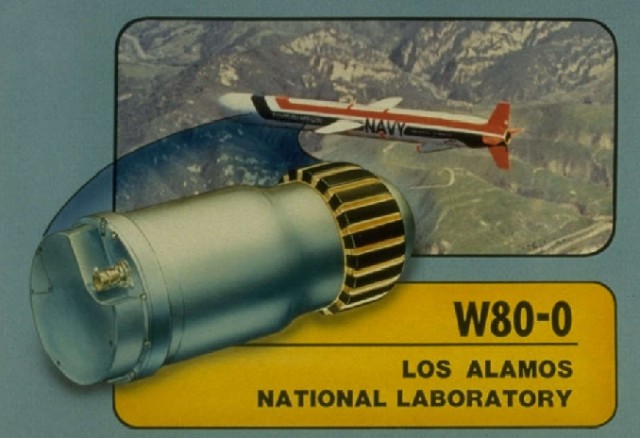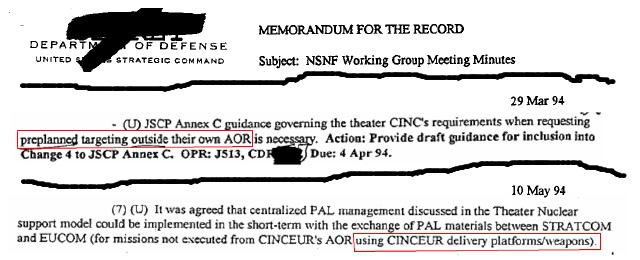US, NATO and Israel Deploy Nukes directed against Iran by Michel Chossudovsky | |
Global Research, September 27, 2007 | |
In late August, reported by the Military Times, a US Air Force B-52 bomber flew from Minot Air Force Base in North Dakota to Barksdale Air Force Base in Louisiana with six AGM advanced cruise missiles, each of which was armed with a W-80-1 nuclear warhead. "... Missiles were mounted on the pylons under its wings. Each of the warheads carried a yield of up to 150 kilotons, more than ten times as powerful as the US bomb that leveled Hiroshima at the close of the Second World War." (See Bill Van Auken, Global Research September 2007)
The Military Times byline was "B-52 mistakenly flies with nukes aboard". The issue was casually acknowledged by The Washington Post and the New York Times. The reports quoted a US Air force spokesman. The matter was offhandedly brushed aside. The incident represented “an isolated mistake” and that “at no time was there a threat to public safety.” (Ibid) :
In recent developments, Wayne Madsen (September 27) has suggested, based on US and foreign intelligence sources, that the B-52 carrying the advanced cruise missiles with bunker buster nuclear warheads was in fact destined for the Middle East. Is the B-52 Barksdale incident in any way related to US plans to use nuclear weapons against Iran? Madsen suggests, in this regard, that the operation of shipping the nuclear warheads was aborted "due to internal opposition within the Air Force and U.S. Intelligence Community", which was opposed to a planned US attack on Iran using nuclear warheads. To grasp the seriousness of the "Barksdale incident", it is important to understand the broader context of nuclear weapons deployment respectively by the US, NATO and Israel. We are not dealing with a single aborted operation of deployment of nuclear weapons to the Middle East. There are indications that a large number of US made nuclear weapons are currently deployed in Western Europe and the Middle East including Israel. This deployment pertains explicitly to targets in Iran. We are dealing with a coordinated military operation in which US Strategic Command (USSTRATCOM) plays a central role. The main coalition partners are the US, NATO and Israel.
1. CONPLAN 8022 CONPLAN 8022 under the jurisdiction of USSTRATCOM sets the stage. It envisages the integration of conventional and nuclear weapons and the use of nukes on a preemptive basis in the conventional war theater. It is described as "a concept plan for the quick use of nuclear, conventional, or information warfare capabilities to destroy--preemptively, if necessary--"time-urgent targets" anywhere in the world." CONPLAN became operational in early 2004. "As a result, the Bush administration's preemption policy is now operational on long-range bombers, strategic submarines on deterrent patrol, and presumably intercontinental ballistic missiles (ICBMs)." (Robert S. Norris and Hans M. Kristensen, Bulletin of Atomic Scientists) CONCEPT PLAN (CONPLAN) 8022 now consists of "an actual plan that the Navy and the Air Force translate into strike package for their submarines and bombers,' (Japanese Economic Newswire, 30 December 2005, For further details see Michel Chossudovsky, Nuclear War against Iran, op. cit.).
2. Nuclear Weapons Deployment Authorization: NSPD 35 (2004) National Security Presidential Directive (NSPD) 35, entitled Nuclear Weapons Deployment Authorization was issued in May 2004. The contents of this highly sensitive document remains a carefully guarded State secret. There has been no mention of NSPD 35 by the media nor even in Congressional debates. While its contents remains classified, the presumption is that NSPD 35 pertains to the deployment of tactical nuclear weapons in the Middle East war theater in compliance with CONPLAN 8022. There are indications that B61-type tactical nuclear weapons have been deployed to the Middle East following NSPD 35. The B-61s would be used against Iran, if Iran were to retaliate to a US or Israeli attack (See Ibrahim Karagul, "The US is Deploying Nuclear Weapons in Iraq Against Iran", Yeni Safak,. 20 December 2005, quoted in BBC Monitoring Europe). 3. Israeli Nukes Israel is part of the military alliance and is slated to play a major role in case the planned attacks on Iran were to be carried out. (For details see Michel Chossudovsky, Nuclear War against Iran, Jan 2006 ). Israel possesses 100-200 strategic nuclear warheads . In 2003, Washington and Tel Aviv confirmed that they were collaborating in "the deployment of US-supplied Harpoon cruise missiles armed with nuclear warheads in Israel's fleet of Dolphin-class submarines." (The Observer, 12 October 2003) . Coinciding with the 2005 preparations to wage air strikes against Iran, Israel took delivery of two new German produced submarines "that could launch nuclear-armed cruise missiles for a "second-strike" deterrent." (Newsweek, 13 February 2006. See also CDI Data Base)
At the outset of Bush's second term, Vice President Dick Cheney dropped a bombshell. He hinted, in no uncertain terms, that Iran was "right at the top of the list" of the rogue enemies of America, and that Israel would, so to speak, "be doing the bombing for us", without US military involvement and without us putting pressure on them "to do it".
Israel is a Rottweiler on a leash: The US wants to "set Israel loose" to attack Iran. Commenting the Vice President's assertion, former National Security adviser Zbigniew Brzezinski in an interview on PBS, confirmed with some apprehension, yes: Cheney wants [former] Prime Ariel Sharon to act on America's behalf and "do it" for us:
Beneath the rhetoric, what we are dealing with is a joint US-NATO-Israeli military operation directed against Iran and Syria, which has been in the active planning stage since 2004. US advisers in the Pentagon have been working assiduously with their Israeli military and intelligence counterparts, carefully identifying targets inside Iran ( Seymour Hersh, http://www.globalresearch.ca/articles/HER501A.html ) In recent developments, at the September 2007 meetings of the Vienna based IAEA, a critical resolution, implicitly aimed at Israel, was put forth which would put Israel's nuclear program "under international purview." The resolution was adopted with the US and Israel voting against it. 4. NATO Nukes. Nuclear Weapons Deployment by Five Non-nuclear States Several Western European countries, officially considered as "non-nuclear states", possess tactical nuclear weapons, supplied to them by Washington. The US has supplied some 480 B61 thermonuclear bombs to five non-nuclear NATO countries including Belgium, Germany, Italy, the Netherlands and Turkey, and one nuclear country, the United Kingdom. These weapons are ready for delivery to "known military targets".
See Details and Map of Nuclear Facilities located in 5 European Non-Nuclear States
As part of this European stockpiling, Turkey, which is a partner of the US-led coalition against Iran along with Israel, possesses some 90 thermonuclear B61 bunker buster bombs at the Incirlik nuclear air base. (National Resources Defense Council, Nuclear Weapons in Europe , February 2005). These military facilities are part of the war plans directed against Iran.
Consistent with US nuclear policy, the stockpiling and deployment of B61 nuclear weapons in Western Europe are intended for targets in the Middle East. Confirmed by "NATO strike plans", these thermonuclear B61 bunker buster bombs (stockpiled by the "non-nuclear States") could be launched "against targets in Russia or countries in the Middle East such as Syria and Iran" ( quoted in National Resources Defense Council, Nuclear Weapons in Europe , February 2005) Moreover, confirmed by (partially) declassified documents (released under the U.S. Freedom of Information Act):
Moreover, the U.S. military made arrangements in the mid-1990s for the use of these nukes outside the area of jurisdiction of European Command (EURCOM).For EUCOM, this would mean responsibility for the the delivery of nukes within CENTCOM (Central Command) area of jurisdiction, meaning that nuclear attacks on Iran and Syria could be launched from military bases in non-nuclear EU/NATO countries.
Documents partially declassified and released under the U.S. Freedom of Information Act reveal that arrangements were made in the mid-1990s to allow the use of U.S. nuclear forces in Europe outside the area of responsibility of U.S. European Command (EUCOM). As a result of these arrangements, EUCOM now supports CENTCOM nuclear missions in the Middle East, including, potentially, against Iran and Syria. Source: http://www.nukestrat.com/us/afn/nato.htm
Nuclear Weapons' Double Standards. Where is the Nuclear Threat? France's President Nicolas Sarkozy Endorses Bush's Pre-emptive Nuclear War Doctrine France accuses Tehran of developing nuclear weapons against mountains of evidence that Iran does not have a nuclear weapons program. The Sarkozy government favors a military operation directed against Iran. Ironically, these threats by President Sarkozy and his Foreign Minister Bernard Kouchner were formulated immediately following the release of the IAEA Report. The latter confirms unequivocally the civilian nature of Iran's nuclear program. According to President Sarkozy in his September 26, 2007 address to the UN General Assembly:
France has also confirmed that it could use its own nuclear warheads estimated at between 200 and 300, on a preemptive basis. In January 2006, (former) President Jacques Chirac announced a major shift in France's nuclear weapons policy. Without mentioning Iran, Chirac intimated that France's nukes should be used in the form of "more focused attacks" against countries, which were "considering" the deployment of Weapons of Mass Destruction (WMD). He also hinted to the possibility that tactical nuclear weapons could be used in conventional war theaters, very much in line with both US and NATO nuclear doctrine (See Chirac shifts French doctrine for use of nuclear weapons , Nucleonics Week January 26, 2006). Chirac's successor, Nicolas Sarkozy has embraced the US sponsored "War on Terrorism". France supports the preemptive use of nuclear weapons in the conventional war theater, broadly following the principles formulated in the Bush Administration's nuclear doctrine, which allows the use of nukes (against Iran or Syria) for "self-defense".  Michel Chossudovsky is the author of the international best America’s "War on Terrorism" Global Research, 2005. He is Professor of Economics at the University of Ottawa and Director of the Center for Research on Globalization. To order Chossudovsky's book America's "War on Terrorism", click here | |
September 28, 2007
Subscribe to:
Post Comments (Atom)





















No comments:
Post a Comment